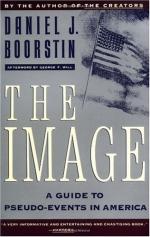
|
| Name: _________________________ | Period: ___________________ |
This test consists of 15 multiple choice questions and 5 short answer questions.
Multiple Choice Questions
1. In Chapter 5 - Section V, Boorstin states that even ____ have become blurred because of the relentless drive of business and consumerism.
(a) Politicians.
(b) Movies.
(c) The seasons.
(d) Books.
2. What does Boorstin describe as a kind of pseudo-event, especially in the sense that they were "more vivid and more impressive than the spontaneous original"?
(a) Photographs.
(b) News media.
(c) Books.
(d) Movies.
3. Boorstin writes that advertising helps to make a shift from what is true to what is what?
(a) Perceived.
(b) Honorable.
(c) Desired.
(d) Believable.
4. Where is Reader's Digest based?
(a) New York, New York.
(b) San Francisco, California.
(c) Portland, Oregon.
(d) Chappaqua, New York.
5. What is the first characteristic of the image, according to Boorstin?
(a) It is believable.
(b) It is synthetic.
(c) It is ambiguous.
(d) It is simplified.
6. Boorstin writes that the image must exist in a kind of liminal state "between expectation and" what?
(a) Reality.
(b) Logic.
(c) Morality.
(d) Truth.
7. What is the second characteristic of the image, according to Boorstin?
(a) It is ambiguous.
(b) It is believable.
(c) It is simplified.
(d) It is synthetic.
8. What system does Boorstin assert affected "traditional forms of achievement," in Chapter 4 - Section VIII?
(a) Democracy.
(b) Communism.
(c) The star system.
(d) The caste system.
9. Boorstin suggests we are in danger if we forget that the experiences which can't be captured by the camera can still be captured in a what?
(a) Experience.
(b) Book.
(c) Dreaming.
(d) Reality.
10. What French sociologist, philosopher, cultural theorist, and photographer is frequently associated with postmodernism and post-structuralism?
(a) Jean Baudrillard.
(b) Jean Francois.
(c) Jean Michele Foucault.
(d) Michael Foucault.
11. What is the sixth characteristic of the image, according to Boorstin?
(a) It is synthetic.
(b) It is ambiguous.
(c) It is simplified.
(d) It is believable.
12. What word does Boorstin suggest we created out of the need to express the specialness of that which is real, in Chapter 6 - Section III?
(a) Non-fiction.
(b) Arbitration.
(c) Capitalization.
(d) Fiction.
13. What refers to reputation or influence arising from success, achievement, rank, or other favorable attributes?
(a) Pseudo-reality.
(b) Narcissism.
(c) Prestige.
(d) Understanding.
14. What book by Walter Lippman does Boorstin discuss in Chapter 5 - Section VI?
(a) Mein Kampf.
(b) Public Opinion.
(c) Beyond Good and Evil.
(d) The Origins of Family.
15. Who developed an early printing press in 1436?
(a) Galileo Galilei.
(b) Henry Watson.
(c) Johannes Gutenberg.
(d) Stephan Michaelson.
Short Answer Questions
1. What is the name of a small press capable of printing small-format pieces such as billheads, letterheads, business cards, and envelopes?
2. Boorstin suggests that the graphic revolution and what else are mostly responsible for the abridgment and the mass production of art?
3. What is the science of language, including phonetics, phonology, morphology, syntax, semantics, and pragmatics?
4. What is the fifth characteristic of the image, according to Boorstin?
5. When did P.T. Barnum purchase Scudder's American Museum?
|
This section contains 454 words (approx. 2 pages at 300 words per page) |

|




